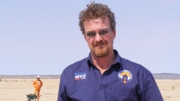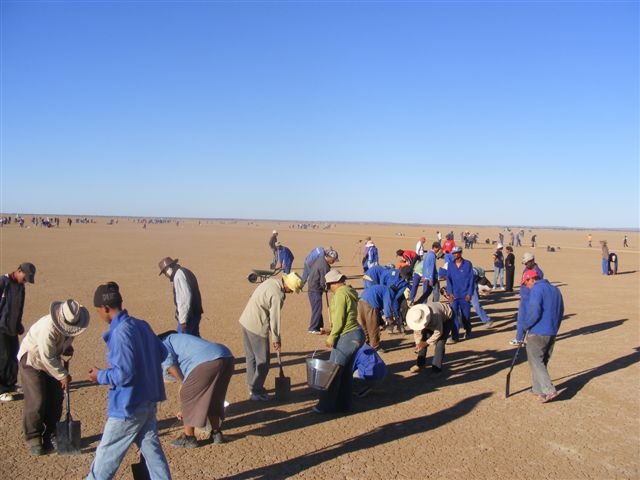
by Rudi Riek
On Monday the 8th of November I woke up at 04h30 at the Molopo Lodge 70 km from Hakskeenpan, I had traveled the 1200km the previous day from Cape Town in order to be on time for this momentous occasion.
I arrived at the pan at 05h30 and was met by a sea of activity, three hundred people had reported for duty.
This was the culmination of nearly two years work, meeting after meeting, survey after survey and permission letter after permission letter, and no the record attempt is not the land speed record, it’s a stone removal record!
The mood was one of excitement and anticipation. Every single one of the people who stood before me was unemployed only the day before. Five communities surrounding the pan had been consulted weeks before and the most needy people in each community identified and contracted to six months on the pan. The towns of Philandersbron, Rietfontein, Groot Mier, Klein Mier and Loubos all within 20 km from the pan each now had about 60 people to contribute to their very small economies.
In one of the many meetings I attended I mentioned that I found it strange that the go ahead was given now, in the hottest month and also at risk of rain any day, the resounding answer I received was: ”Christmas is around the corner, we need to put food on people’s plates!”
I was told that this is currently the largest upliftment programme in the Northern Cape and I can tell you that when I tell most people about the task ahead they think it impossible and even madness, not these people, to be brutally honest, I don’t they would have even flinched if I told them the track was 50 km long, all they know is, they are bringing home money for the first time in a very long time.
For those of you that are wondering what I am on about and have not read the previous posts regarding the track, let me give you some scary facts:
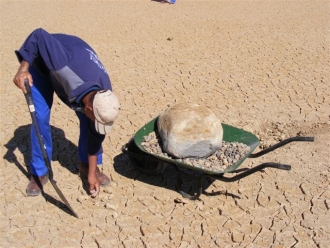 The track that needs to be cleared is 20 km long and at its widest is 1,5 km wide. It is covered in various degrees of density with stones. The area that needs to be cleared is 24 million square metres, this equates to two thousand four hundred hectares or 48,000 football pitches. ALL of it needs to be cleared by hand!
The track that needs to be cleared is 20 km long and at its widest is 1,5 km wide. It is covered in various degrees of density with stones. The area that needs to be cleared is 24 million square metres, this equates to two thousand four hundred hectares or 48,000 football pitches. ALL of it needs to be cleared by hand!
How did we calculate how long it would take to clear? Well we broke the track up into sections and categorized the sections by their degree of stone coverage, very basic mind you, I’m not a scientist, just a realist. We then did a test on one day in all these areas and came up with a rough formula:
|
Light coverage |
= 150m2 per hour per labourer |
|
Medium light coverage |
= 100m2 per hour per labourer |
|
Medium coverage |
= 80m2 per hour per labourer |
|
Heavy coverage |
= 40m2 per hour per labourer |
 The staff work 8 hours per day
The staff work 8 hours per day
Light zone:
3km x 500m track = 1 500 000 m2
4,3km x 1,5km (track and safety zone) = 6 450 000m2
Total m2 light Zone = 7 950 000m2 (seven million nine hundred and fifty thousand m2)
Thus: 300 people x 150m2 x 8 = 360 000 m2 per day
7 950 000m2 / 360 000m2 = 22 days
Medium Light Zone
1,7 km (track and safety) x 1500 = 2 550 000m2 (two million five hundred and fifty thousand m2)
Total medium light zone = 2 550 000m2
Thus: 300 people x 100m2 x 8 = 240 000m2 per day
2 550 000m2/ 240 000m2 = 11 days
Medium Zone
3km x 500m track = 1 500 000 m2 (one million five hundred thousand m2)
5,1 km x 1500m = 7 650 000 m2 (seven million six hundred and fifty thousand m2)
Total Medium Zone = 9 150 000 m2 (nine million one hundred and fifty thousand m2)
Thus: 300 people x 80m2 x 8 = 192 000m2 per day
9 150 000m2 / 192 000m2 = 48 days
Heavy Zone
2,9km x 1500m = 4 350 000m2
Total Heavy Zone = 4 350 000m2 (four million three hundred and fifty thousand m2)
Thus: 300 people x 40m2 x 8 = 96 000m2 per day
4 350 000m2 / 96 000m2 = 45 days
Total days: 126 days
Oops, got a bit side tracked there, forgot I was trying to make this interesting reading, back to why I woke up so early, you see, it reaches 40 degrees Celsius on the pan in summer and the best time of the day to work is in the early morning, the staff start at 06h00 and finish for the day at 16h00 with a breakfast break and a lunch break.
 So you must be wondering at this stage, how do we manage not to miss a spot, well, day one was a learning curve for us, you see, three hundred people on paper sounds like a nice figure but boy oh boy it’s a lot of people.
So you must be wondering at this stage, how do we manage not to miss a spot, well, day one was a learning curve for us, you see, three hundred people on paper sounds like a nice figure but boy oh boy it’s a lot of people.
After trying our best not to get friends to bunch together and groups of people not taking responsibility for certain areas on the first day we had a brilliant suggestion by one of the staff. We purchased a couple of kilometres of twine and divided the central track which we are clearing first into 14 sections each 35,7 metres wide. We already had 15 teams each with a team leader so we gave each team a section to complete and take responsibility for a roped off section. The remaining team was split into wheelbarrow men and rope men.
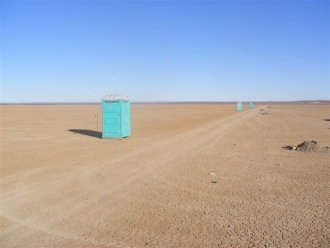 The logistics around managing the crew is a challenge on its own. We have 16 toilets spread in intervals of 100m on both sides of the track, these toilets are moved twice daily to keep up with the progress line. We have water tankers on either side of the track and approximately 3000L of fresh water is consumed daily. We have 4 medical personnel that watch for signs of sunstroke and dehydration as well as tend to any possible injuries. There are only two busses in the community so the remaining 180 people are transported with 18 enclosed pickups from and to their homes daily. Each team has its own gazebo to have lunch under and to keep the water bottles and food cool during the day. At the time I took these pictures the protective gear was still on its way but each team member will receive a cricket hat, protective clothing, boots and gloves.
The logistics around managing the crew is a challenge on its own. We have 16 toilets spread in intervals of 100m on both sides of the track, these toilets are moved twice daily to keep up with the progress line. We have water tankers on either side of the track and approximately 3000L of fresh water is consumed daily. We have 4 medical personnel that watch for signs of sunstroke and dehydration as well as tend to any possible injuries. There are only two busses in the community so the remaining 180 people are transported with 18 enclosed pickups from and to their homes daily. Each team has its own gazebo to have lunch under and to keep the water bottles and food cool during the day. At the time I took these pictures the protective gear was still on its way but each team member will receive a cricket hat, protective clothing, boots and gloves.
We have 150 buckets, 150 spades, 20 wheelbarrows, 50 brooms and 50 rakes on site. We are still looking for sponsorship for a pair of sunglasses for each team member as well as a daily supplement like rehydrate or game to help prevent dehydration, if any of you reading this thinks they can help with that please let us know!
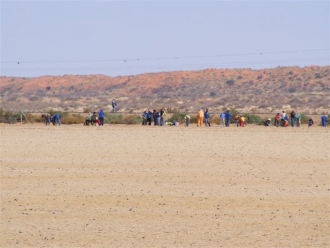
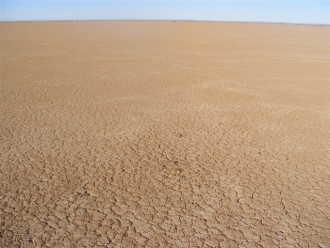
Above left: Surface before stone removal. Above right: Surface after stone removal!
 In addition to the stone removal phase, we also started the road removal phase this week. One of the major reasons Hakskeenpan was initially discarded as a possible option is due to the elevated dirt road that runs through the pan. This road has now been decomissioned by the Northern Cape Government and needs to be removed and the surface below it needs to be brought to the same consistency and level as the rest of the pan. The section that needs to be removed is about 50cm high, 6m wide and 1500 metres long. It was a tense moment when the front end loader removed its first load because up until that point we had not been 100% sure that the material the road consists of would be easily removed
In addition to the stone removal phase, we also started the road removal phase this week. One of the major reasons Hakskeenpan was initially discarded as a possible option is due to the elevated dirt road that runs through the pan. This road has now been decomissioned by the Northern Cape Government and needs to be removed and the surface below it needs to be brought to the same consistency and level as the rest of the pan. The section that needs to be removed is about 50cm high, 6m wide and 1500 metres long. It was a tense moment when the front end loader removed its first load because up until that point we had not been 100% sure that the material the road consists of would be easily removed
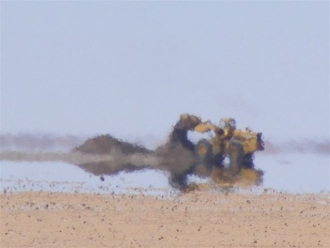 Fortunately this phase is also going exceptionally well, the road consists of clay only, it is a more sedimental clay than the rest of the pan surface but clay none the less, there are no stones and as a result the road is being removed cleanly from the pan surface and at a tremendous pace. The team is currently removing approx. 100 metres of road per day which equates to 60 truck loads or 600 cubic metres of soil per day. The soil is dumped into the borrow holes that are part of the track safety zones, these borrow holes will be leveled and compacted once full. Once the road has been removed the remaining surface will be precision graded to match the rest of the track.
Fortunately this phase is also going exceptionally well, the road consists of clay only, it is a more sedimental clay than the rest of the pan surface but clay none the less, there are no stones and as a result the road is being removed cleanly from the pan surface and at a tremendous pace. The team is currently removing approx. 100 metres of road per day which equates to 60 truck loads or 600 cubic metres of soil per day. The soil is dumped into the borrow holes that are part of the track safety zones, these borrow holes will be leveled and compacted once full. Once the road has been removed the remaining surface will be precision graded to match the rest of the track.
In addition to the road removal the road works team will also be filling all indentations and removing all other obstructions the stone removal team cannot do manually. They will also grade access roads for the public and the Bloodhound team.
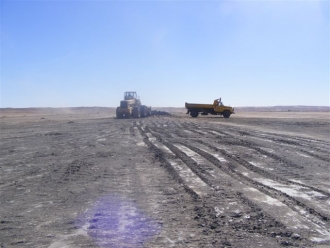
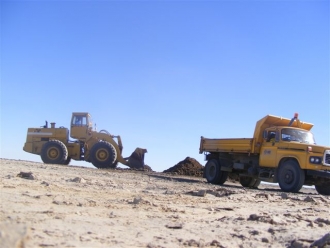
On the 18th of November the Premier of the Northern Cape and her cabinet will officially launch this project as sponsors of the track preparation. We have a long six month’s ahead of us and I suspect we will be rained out at some point but by starting the project now before the rain starts we have allowed ourselves the opportunity to witness what impact the rain will have on our disturbance and should we need to alter our modus operandi we will have the whole of 2011 to do so.
We will keep you updated as to our progress on a regular basis.


